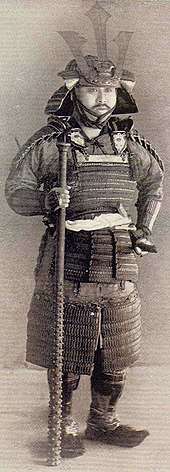Kanabō
The kanabō (金棒) (literally: "metal stick") is a spiked or studded two-handed war club used in feudal Japan by the samurai. Other related weapons of this type are the nyoibo, konsaibo,[1][2] tetsubō (鉄棒), and ararebo.[3] Related solid iron weapons with no spikes or studs are the kanemuchi (kanamuchi) and the aribo (gojo/kirikobo).[4]

Description
Kanabō and the other related types of these club-like weapons were constructed out of heavy wood, or made entirely from iron, with iron spikes or studs on one end. One or both ends of the wooden type clubs could be sheathed in iron. Kanabō type weapons came in all sizes and shapes with the largest ones being as tall as a man and a two-handed weapon while the smaller lighter ones were primarily one-handed and the length of a forearm.
The shape could be similar to a baseball bat, with a thick heavy end tapering towards a slender handle with a pommel, or they could be straight all the way from the handle to the end. The shaft cross-section could be round (as in a baseball bat) or polygonal; that is, it might be multi-faceted with flat surfaces arrayed around the central axis.[5][3][6]
Mythology
The kanabō was also a mythical weapon, often used in tales by oni (Japanese demon/ogre) since they were reputedly extremely strong.[7][8] Today there is a saying in Japanese: "Like giving a kanabō to an oni" – which means to give an extra advantage to someone who already has the advantage (the strong made stronger).[9] A western rendering might be "like adding fuel to a fire".
Gallery
- Kanabō
 A statue of an oni armed with a kanabō.
A statue of an oni armed with a kanabō.- Close up picture of the iron spikes of a kanabō-tetsubō.
 Japanese kanabō.
Japanese kanabō. Small antique Japanese wood club with iron-covered ends and iron studs (ararebō).[3]
Small antique Japanese wood club with iron-covered ends and iron studs (ararebō).[3]- Old Japanese wood club with iron spikes, kanabō or tetsubō, 4′ 9″ long and 4 lb in weight.
- A small tetsubō.
- Close-up picture of the iron studs on an antique Japanese ararebo, a small version of the kanabo.
References
- Kogan, Daniel, and Sun-Jin Kim (1996). Tuttle dictionary of the martial arts of Korea, China & Japan. p. 168.
- Pauley, Daniel C. (2009). Pauley's Guide: A Dictionary of Japanese Martial Arts and Culture. p. 90.
- Mol, Serge (2003). Classical weaponry of Japan: special weapons and tactics of the martial arts. Kodansha International. p. 91.
- Serge Mol (2003). Classical weaponry of Japan: special weapons and tactics of the martial arts. Kodansha International. p. 106.
- Secrets of the samurai: a survey of the martial arts of feudal Japan. By Oscar Ratti, Adele Westbrook. p. 305
- Heroes of the Grand Pacification: Kuniyoshi's Taiheiki eiyū den, p. 184
- Trimnell, Edward. Tigers, Devils, and Fools: A Guide to Japanese Proverbs. p. 115.
- Ishibashi, Tanzan. The Oriental Economist, Volume 43. p. 45.
- The netsuke handbook. Reikichi Ueda. p. 175.
External links
